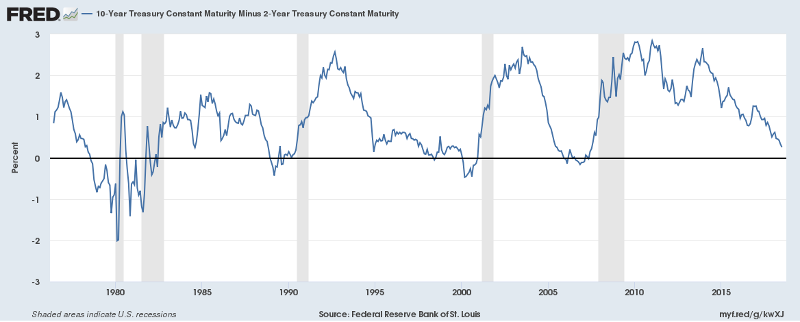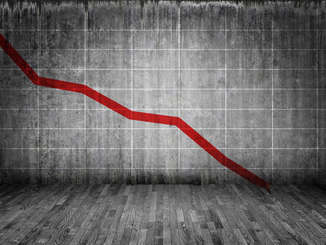One key indicator of the economy’s health that economists and financial market observers look at is the yield curve. In particular, they look at the spread between the yield on 2-year Treasury bonds and 10-year Treasury bonds. As the difference between the yield on those two maturities narrows, the yield curve is said to be flattening. And in some cases the yield on the 2-year bond exceeds that of the 10-year bond, in which case the yield curve is said to be inverted.
That happens because investors judge that economic conditions in the long term will deteriorate. Traditionally that inverted yield curve has been a leading indicator of a coming recession. It isn’t a cause of the recession, obviously, but an indicator that investors are getting wary, and for good reason. And right now the yield curve is flattening significantly and threatening to invert.

Right now the difference in yield between 2-year and 10-year Treasuries is a mere 24 basis points. At the beginning of July it was 30 basis points. At this rate the yield curve will likely invert in the next couple of months, indicating that there’s a high likelihood of recession within the next year or two.
Of course, those of us who understand and follow monetary policy have been warning of this for a while. The business cycle isn’t endemic to the free market, nor is it an automatic cyclical process that can be predicted with any degree of accuracy. It is the result of government monetary manipulation.
We know that the Federal Reserve pumped trillions of dollars worth of new money into the financial system, and we know that that money has resulted in a stock market and asset bubble. We know that that bubble will burst once the Fed slows down the pace of its money creation, which is what we’re starting to see happen.
The inverted yield curve will merely be the icing on the cake, the nail in the coffin that confirms for mainstream observers that a recession is on the way. But many investors have known that for a while.
They saw the rate at which stock markets continued to make huge gains month after month from early 2016 to early 2018. They knew that easy money was the reason behind those gains and that those gains couldn’t continue indefinitely. And even if they didn’t transition away from stocks right at the peak of the market, the actions of markets over the past few months has certainly provided them with ample warning of the coming correction.
Savvy investors have already started to position themselves for the coming downturn, getting out of stocks and bonds and putting their money into gold, silver, and other alternative assets. The warning signs are there for those who choose to see them, and who want to protect their retirement assets from losing value when the markets finally correct.
This article was originally posted on Goldco.





